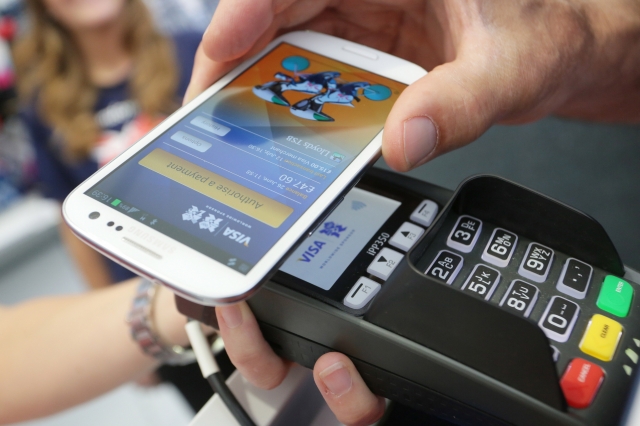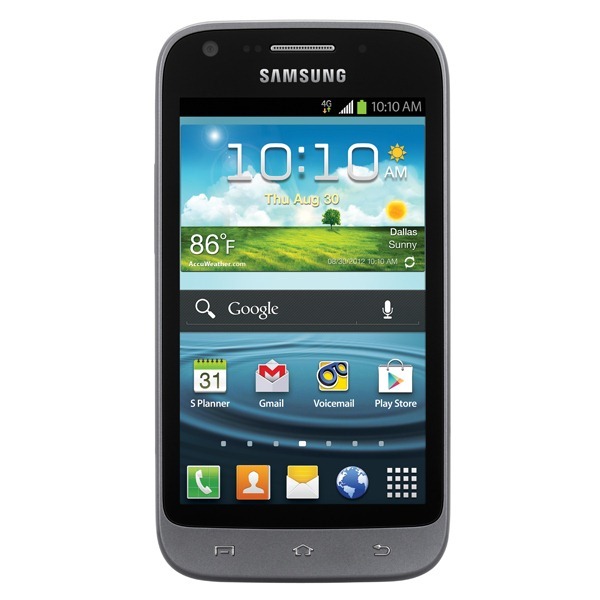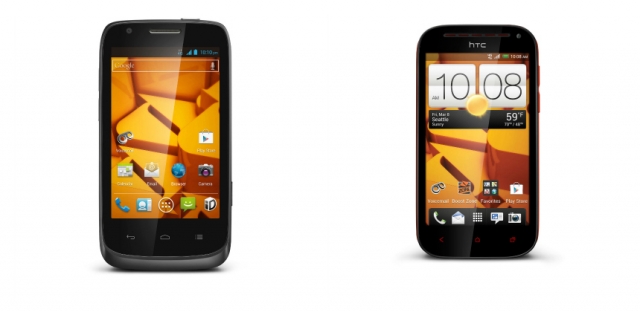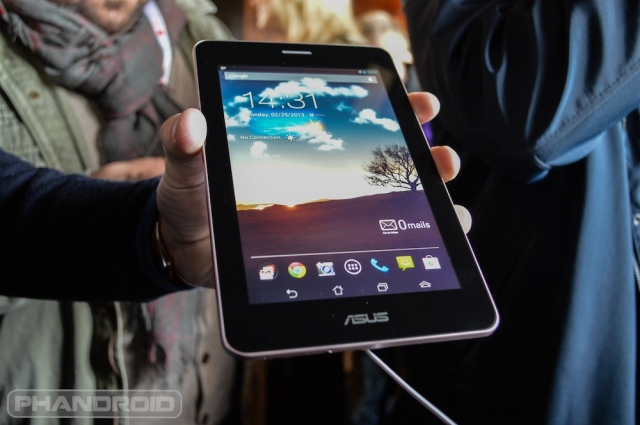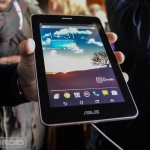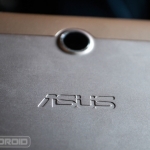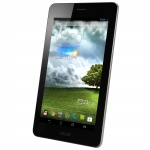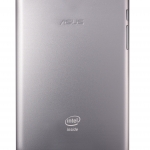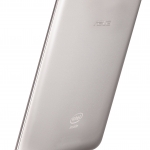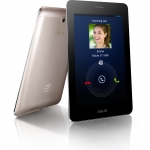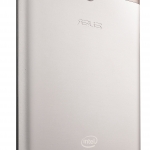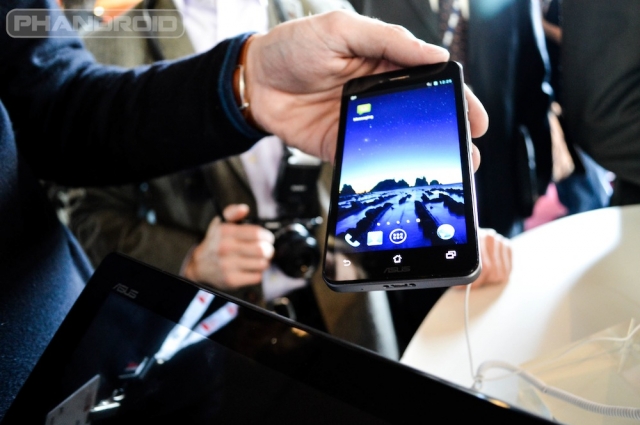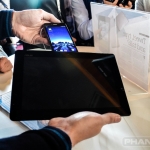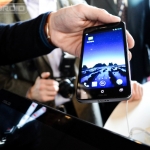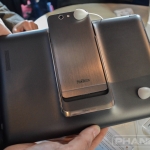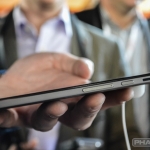Android Authority |
- Samsung Galaxy Victory 4G LTE lands on Virgin Mobile for $300 contract-free
- How to talk on a 7-inch smartphone, Asus Fonepad presentation explains [video]
- Dual-screen NEC Medias W global smartphone/tablet makes an appearance at MWC 2013
- Android Authority On Air and Cruzerlite Contest Winners
- Google X Phone vs Galaxy S4: the battle for Android in 2013?
- Samsung Galaxy Note 8.0 vs Google Nexus 7 [video]
- Hands-on with the new PadFone Infinity. Bonus: Asus interview
- Video: benchmarking the Intel Clover Trail+ Lenovo K900
- Asus PadFone 2 heading to UK on March 1st for £599.99
- The Chromebook Pixel project
| Samsung Galaxy Victory 4G LTE lands on Virgin Mobile for $300 contract-free Posted: 26 Feb 2013 02:34 AM PST
If you're looking to grab a new LTE-equipped phone on Virgin Mobile, keep your eyes peeled for the Samsung Galaxy Victory 4G LTE, a neat-looking handset with a pretty decent spec sheet that was first launched back in September on Sprint. The Galaxy Victory 4G LTE can be had for $299.99 from the prepaid carrier's online store. That's a rather tempting off-contract price for the sweet package that you'll be receiving. Virgin Mobile's first LTE offering comes with a 4-inch WVGA display, a 1.2GHz dual-core Qualcomm MSM8960 Snapdragon processor, 1GB of RAM, 4GB internal storage, microSD support (up to 32GB), 5MP main camera, 1.3MP front cam, NFC, and a 2,100mAh battery. Adding to the sweetness is the Android 4.1 Jelly Bean that the phone ships with – unlike the Sprint variant of the device that's still stuck on Ice Cream Sandwich. In case you're wondering, Virgin's Beyond Talk unlimited data and messaging plans start at $35 per month. |
| How to talk on a 7-inch smartphone, Asus Fonepad presentation explains [video] Posted: 25 Feb 2013 07:28 PM PST
Asus on Tuesday at MWC 2013 in Barcelona, Spain, announced two new devices – well three, depending how you count them – the Asus Padfone Infinity smartphone/tablet combo and the 7-inch Nexus 7-like Asus Fonepad… smartphone/tablet combo. We're going to focus on the latter right now, a 7-inch device that can essentially act as your everyday handset, no matter how crazy that sounds. Yes, the Fonepad has voice call support via 3G. But yes, talking to a 7-inch phone, the regular way, can be awkward. Considering that the device will be priced very competitively, you'd think that Asus would at least try to offer a comfortable (read: not crazy) solution of using it like a smartphone in the official Asus Fonepad presentation videos, such as buying an equally affordable headset.
But no, Asus doesn't do that. The company has the guts / nerve to actually show us Fonepad users talking on the device like you'd do with a regular phone, raising it up to your ear and so on. On video. Even HTC has its own Mini headset solution for an even smaller smartphone, the 5-inch Droid DNA / Butterfly. Yes, at least the first video shows us much more than that, as Asus explains the design principles behind the Fonepad, but we keep focusing on all the people raising the 7-inch tablet to their ears. Hopefully nobody will drop it when using it like that – but that's why the Fonepad features a back metal case doesn't it? To prevent unwanted accidents resulting from talking on it?
We're not mad at Asus actually, but very amused – that's not to say that talking on 5.x or 6.x phones gets is any easier, but a 7-inch device shouldn't be used like a phone. From the looks of it, Fonepad is definitely a great tablet, and, as long as you pair it with a headset, it can be a great phone also. But please, pretty please with sugar on top, don't use it like Asus suggests you should. Even Jonney Shih doesn’t seem to be able to keep a straight face when presenting the Fonepad concept. On a different Galaxy Note (pun intended,) you can also use phone features, but the device is even bigger. Hopefully Samsung will also teach Galaxy Note 8 buyers how to talk on 8-inch phones. Back to Asus though, what the company doesn't show us in this video is how we'd pack the Fonepad in our pockets, you know, after using its phone features, because that's where phones usually go. Maybe the dude in the suit would care to explain… Let’s hear it from future Fonepad buyers though: would you talk on a 7-inch phone? |
| Dual-screen NEC Medias W global smartphone/tablet makes an appearance at MWC 2013 Posted: 25 Feb 2013 06:35 PM PST
This isn't the first time we're talking about the NEC Medias W dual-screen Android smartphone, but the device has been spotted at MWC 2013 in Barcelona, Spain, and could provide insight into what future smartphone/tablet combos could offer. Best of all, this particular Medias W unit seems to be an international prototype, although NEC isn’t ready to make any announcements yet. The Medias W features two 4.3-inch touchscreen displays, one on either side of the smartphone, at least in smartphone mode. Because the hinge keeping the two sides together can also offer you a 5.6-inch tablet mode, as shown in the pictures. The Medias W is not a high-end Android device, and it may have some difficulty fighting even mid-rangers this year, but it proposes us another alternative form factor in a world where smartphone displays can only go so high up – after all we've already seen smartphones that want to be tablets and tablets that want to make phone calls at this year's MWC show, so why not consider NEC's solution of increasing the display size. When it comes to specs and features, you can expect this dual-screen device to offer you two 4.3-inch LCD displays featuring a 960 x 540 resolution (each), 1.5GHz dual-core Qualcomm Snapdragon S4 processor, 1GB of RAM, 16GB of storage, microSD support, 8-megapixel camera (no front-facing camera here,) 2100mAh battery and Android 4.1 Jelly Bean under the hood.
While Japanese Android fans will get their hands on the NEC Medias W at some point in April, it's not clear when international consumers will be able to order one for themselves. |
| Android Authority On Air and Cruzerlite Contest Winners Posted: 25 Feb 2013 05:51 PM PST
Last week, Android Authority On Air reached a milestone, episode 52. For our 1 year anniversary with the Android Authority On Air show, we partnered with Cruzerlite to bring you 10 $15 gift cards. Thanks for watching live on Google+, YouTube, SoundCloud, iTunes, Stitcher or wherever you happened to find us. The final contest results are in and listed below. If your name is below, you will be contacted in the near future by email. Congrats! If you didn’t win, better luck next time. Stay tuned to Android Authority so you don’t miss any of our upcoming giveaways.
Don’t forget to tune in every Thursday night at 9:30pm EST for the Android Authority Air Show! |
| Google X Phone vs Galaxy S4: the battle for Android in 2013? Posted: 25 Feb 2013 05:41 PM PST
A new Wall Street Journal report reveals that Google is indeed worried about Samsung's increased role in the Android ecosystem, with the South Korean company being currently the number one Android smartphone and tablet maker when it comes to market share and profits. We say indeed because we have speculated more than once that Samsung's impressive lead could become a problem for Google at some point in the future. In fact, just recently an unofficial look into googling habits from potential buyers for the past year showed that some customers may already be confusing "Android" with "Galaxy," with the later being the strongest device Android brand out there. At the same time, Samsung is a great ally in the Android vs Apple war, one that Google can't really afford to lose, so the Google-Samsung relationship is definitely one to follow in the coming months, especially if the latter is unhappy. The reportAs it always does, the WSJ has spoken with people familiar with the matter, who remain unnamed, but are able to comment on this particular business relationship. According to them, Google executives are worried about Samsung's influence in the Android ecosystem and what the giant corporation could do in the future, as its market share increases:
The worriesApparently Google is worried that Samsung may affect its bottom line by demanding a larger cut of its mobile ad-based profits in the future – currently Samsung is getting 10% of the take – and/or that Samsung may ask for special favors, such as early access to future Android updates. To Google, mobile ads are worth 8 billion a year according to recent estimates, and the number will certainly grow in the future. That 10% accounts for one hefty pay off to Samsung, and the South Korean giant has apparently "signaled that it might want more." Samsung is pulling some serious cash from Android device sales – $60 billion in 2012 alone – so should it demand more cash from Google ads? Well the company may have its own reasons for being sort-of angry with Google, including the Motorola purchase, or the Nexus 7 and Nexus 4 pricing structures, which may have affected to some extent Samsung's own bottom line. So Samsung may feel it's entitled to make up for lost Galaxy smartphones and tablet sales with more of Google’s money. After all, Samsung is in it for hardware profits, and needs to make money off device sales, without being able to rely to other revenue streams such as the Google Play Store or online advertising. Is there also a worst-case scenario that Google fears, like Samsung completely moving to a different mobile platform? Samsung is still developing its own Linux-based OS, Tizen, which doesn't look half-bad considering the recent screenshots we've seen. In fact, it looks like Tizen will become an even more important part of Samsung, with bada merging into Tizen in the future. Not to mention that Intel is also a very interested party in the Tizen project, as it could become an important play in its attack on the mobile market. While it seems like a strange proposition for now, what if Samsung decided, at any point in the future, to move from Android to its own OS? The more it builds its Galaxy brand, the more customers will follow, without knowing or even caring that their next-gen Galaxy devices won't run Android anymore. Sure, Android fans will stick with Android, and Samsung would lose customers in such a case, but the more power it can leverage in the Android landscape, the more it can present such a scenario to Google and make more demands. We’re not forgetting that there's always Windows Phone, a mobile OS Samsung is also working with, but one that wouldn’t necessarily fit to Samsung’s needs as a main mobile OS. More realistically though, Samsung would only need to remove Google services from its Android smartphones and tablets – in an Amazon-like manner – to get Google’s attention. The solutionIf Google does indeed have a Samsung problem, then should we view the upcoming Google/Motorola X Phone as a possible solution to it? Are we going to see Google silently fight Samsung this year in an X Phone vs Galaxy S4 clash of titans?
Google has always said – at least so far – that it won't give preferential treatment to Motorola now that it owns it. We have no idea whether it meant it, or whether it was all just a show, so other Android device makers won't worry about competing against future Motorola Nexus devices. Moreover, according to a Google exec, the Motorola purchase was all about the patents – and now we hear it was a hedge bet according to Rubin. The company didn't release any special Android device, not counting the new RAZR models, and did say recently that it still needs time until it’s able to make its own hardware. But that might change with the Google X Phone, an extraordinary device expected to arrive at Google I/O in mid-May sporting high-end specs and running Google's future Android 5.0 Key Lime Pie without actually being a Nexus device. The X Phone has been spotted in various rumors and leaks so far, without being actually confirmed, but this time around WSJ does mention it:
The fact that the WSJ talks about the device gives added weight to the current X Phone reports out there – let's not forget that just a few days ago, the same publication talked about Google's Chromebook, which was launched hours after that particularly story hit the virtual presses. This time around, an X Phone announcement will not be just around the corner, but the device is looking more and more real. The Galaxy S4 is going to be unveiled on March 14 at a special event in New York – which we'll attend live – therefore at least two months before the X Phone becomes official. We're certainly interested to see how this particular battle will play out, since in light of this WSJ report the X Phone looks more like a Galaxy S4 rival than a device meant to further chip away at Apple's market and profit share – but yes, it will do both if successful.
Without mentioning any details about the device, the WSJ can certainly make Android fans dream about a high-end Motorola handset that would fight Samsung flagship devices:
Yes, other Android OEMs would also be hit by the X Phone, and could put Google in a strange situation. But Google has been in a strange situation before and was able to sort-of deal with that problem. Looking back at how it all started – assuming Samsung disliked the Nexus 7 and Nexus 4 pricing policy – we'll remind you that Google had to come out with a cheap Nexus 7 and to fight off the Amazon threat rather than to hurt Apple’s iPad sales, even if that mean angering regular Android partners in the process. Similarly, it could now have to launch a X Phone to prevent the Galaxy S4 from selling as well as it's expected to sell, even if that means, again, angering everyone else in the process. Naturally, don’t expect anyone to confirm that the X Phone is a product Google needs to prevent Samsung from getting an even larger share of the Android pie. The WSJ's sources could always be wrong, and we could be wrong speculating on the state of the Google-Samsung relationship. Maybe the X Phone is meant to be Google's own iPhone rival rather than a competitor to high-end Android devices. Time will tell. From a different point of view, Google is said to have "high hopes" for the HTC One or the recently unveiled HP Slate 7 to threaten Samsung's dominance in the Android ecosystem, although these are products that aren't yet selling, and it will be a while until they hit stores. Does Google plan to help either HTC and/or HP in any particular manner? Again, time will tell and we'll be here to report everything. But since other high-end devices are yet to show their muscles, the X Phone – or the promise of an X Phone – could keep plenty of Android device buyers at home when the Galaxy S4 launches, especially those customers that prefer Nexus devices over anything else. Earlier today we witnessed Samsung crashing the MWC 2013 party by casting a long Galaxy S4 shadow over the show. In its turn, does Google have reason to crash Samsung's Galaxy S4 party in the coming weeks and months with more X Phone rumors primed to hit the web on a more regular basis? We'll just have to wait and see.
What high-end phone would you rather buy, a Google X Phone or a Samsung Galaxy S4? |
| Samsung Galaxy Note 8.0 vs Google Nexus 7 [video] Posted: 25 Feb 2013 03:12 PM PST
Coming into MWC 2013, the Samsung Galaxy Note 8.0 was hardly a secret, as numerous leaks had already painted an accurate picture of Samsung's response to the Apple iPad Mini. But although it's no surprise that the Galaxy Note 8.0 was officially announced by Samsung, the fact remains that this S-Pen-enabled tablet is likely to play an important role in the evolution of the Android ecosystem for at least the first half of the year. When covering new mid-sized Android tablets, or even any category of Android tablets for that matter, one interesting way of appreciating its future success is a comparison with the best selling Android tablet of all times, the Google Nexus 7. The general rule of thumb throughout 2013 should be that only tablets that noticeably improve on the specs of the Nexus 7 have chances at selling well and thus making a dent in the ecosystem's yearly timeline. However, the rule becomes slightly distorted in the context of this article due to the fact that Samsung is not your average Android manufacturer. I'm quite confident that a tablet from the South Korean manufacturer might provide better results (more units sold, better profit margins) than a corresponding tablet from any other manufacturer. With this in mind, let us start pitting the Samsung Galaxy Note 8.0 against the Asus-manufactured Google Nexus 7.
DisplayThe Google Nexus 7 uses a 7-inch LED-backlit IPS display that runs at a resolution of 1280 x 800 pixels. The Pixel Per Inch density (PPI) rests at 216, the colors are accurate, the viewing angles are good, and despite not excelling in the brightness department, it does feature great contrast ratios. Overall, we are talking about the modern standard in terms of acceptable displays. As the name suggests, the Samsung Galaxy Note 8.0 uses an 8-inch LCD display, one that uses the same resolution as the display on the Nexus 7: 1280 x 800 pixels. However, due to its larger display area, the PPI ratio falls at 189. The overall display quality is similar to that of the Galaxy Note 10.1, meaning there's nothing to get really excited about. Verdict: If display quality is what you're looking for, the Nexus 7 is definitely the better choice. Design and Build QualityAlthough it it does not feature exceptional build quality, the Nexus 7 is quite a compact slate. Add the soft touch back and narrow(ish) side bezels, and the end product is comfortable to hold and use. The Nexus 7 measures 198.5 x 120 x 10.5 mm (7.81 x 4.72 x 0.41 in) and weighs in at 340g (11.99oz).
There's no easy way to say it, but the Samsung Galaxy Note 8.0 is certainly not the prettiest tablet to look at. Although it's quite thin, the Note 8.0 is basically an oversized Note 2 with huge bezels and a very plasticky build. The Samsung Galaxy Note 8.0 measures 210.8 x 135.9 x 8 mm (8.30 x 5.35 x 0.31 in) and weighs in at 338g (11.92oz). Verdict: Looks may be subjective, but build quality isn't, so the Nexus 7 takes this round as well! HardwareCPU, GPU & RAMThe Google Nexus 7 uses an underclocked version of the popular Nvidia Tegra 3 chipset. This translates into a 1.2GHz quad-core processor, an Nvidia GeForce ULP GPU and 1GB of RAM memory. In the Samsung corner, the Note 8.0 makes use of the same SoC as the Galaxy Note 2, namely an overclocked version of the Exynos 4 Quad. The 1.6GHz quad-core processor, Mali 400 MP GPU and 2GB of RAM make the Note 8.0 a very fast tablet.
Internal and Expandable StorageThe Samsung Galaxy Note 8 will launch in 16GB and 32GB versions and will be able to work with microSD cards of up to 64GB. Although an 8GB version was initially released, the Google Nexus 7 is now selling in 16GB and 32GB versions. In pure Nexus style, there is no microSD card slot. BatteryBoth the Samsung Galaxy Note 8 and the Google Nexus 7 come similarly equipped in the battery department, featuring a 4600mAh battery and a 4325mAh battery, respectively. CameraThe Samsung Galaxy Note 8 uses a 5MP primary camera and a 1.2MP secondary sensor for video calling, while the Google Nexus 7 features a front facing 1.2MP camera only. Verdict: The Samsung Galaxy Note 8 features considerably better hardware specifications than the Google Nexus 7.
Android Version and Software TweaksAs far as this section of our article is concerned, these are two very different tablets. On one hand we have the Nexus 7 running on Android 4.2 Jelly Bean, a device that will be always up to date with the latest version of vanilla Android. In the other, we have the Samsung Galaxy Note 8, a tablet that currently runs Android 4.1 and might not have access to timely updates in the future, but tries to compensate with an array of software tweaks. While Samsung's TouchWiz custom Android UI is often criticized for its design, the Galaxy Note 8 not only comes with the Samsung Smart Functions and all the software features that people love about the Galaxy Note 2, but also throws in S-Pen compatibility in the equation. This is Samsung's tradeoff for that sub-par display: a digitizer that can turn your tablet into a creative or lucrative powerhouse. Verdict: This round seems to be a draw as the Nexus 7 runs on pure Android, but the Galaxy Note 8 can do some really neat tricks as well. ConclusionAlthough they are both mid-sized, mid range Android tablets, the Samsung Galaxy Note 8 and the Google Nexus 7 could not be any different. The Nexus 7 still remains the go-to solution if you're interested in the overall quality level, but the Samsung Galaxy Note 8 might still find a way to your heart thanks to its speedy internals and S-Pen capabilities. The fact that the Galaxy Note 8 can place calls via 3G is probably not going to be much of a factor, although the price (a vital element that Samsung has yet to reveal) will. If the rumors placing the Galaxy Note 8 at roughly $300 come true, than sure, the Galaxy Note 8 is a viable choice for many. On the other hand, Samsung's chance to a good community reaction decreases as it passes this critical price threshold and start nearing the price of the Galaxy Note 8's true competitor, the Apple iPad Mini. What do you guys make out of this comparison? Would you go for the Nexus 7's better display and timely Android updates over the Galaxy Note 8's speedier hardware and S-Pen capabilities? |
| Hands-on with the new PadFone Infinity. Bonus: Asus interview Posted: 25 Feb 2013 01:51 PM PST
Today at MWC, Asus has unveiled the newest iteration of its unique PadFone line. Dubbed PadFone Infinity, the phone and station combo is slicker than ever, thanks to a new aluminum build, a slimmer profile, and a super scrisp full HD screen. Without any exaggeration, the PadFone Infinity is one of the best smartphones out there right now. Features like the Snapdragon 600 processor, the full HD 5-inch display of 441ppi, and the 13MP camera put it right beside the new HTC One and the LG Optimus G Pro. Add the gorgeous looking station (also in aluminum, also full HD) and you got yourself a truly amazing piece of technology. Here’s the full specs sheet of the Asus PadFone Infinity:
We had the chance to spend some time with the PadFone Infinity today at MWC. Moreover, Darcy sat down with the project manager of the PadFone for a quick interview. Check it out below. |
| Video: benchmarking the Intel Clover Trail+ Lenovo K900 Posted: 25 Feb 2013 12:45 PM PST
The K900 has been unveiled at CES in Las Vegas, where we got to take Lenovo's gorgeous device for a quick spin. Now, the Clover Trail+ equipped device has made an appearance at Mobile World Congress, and we were curious to see how Intel's first dual-core mobile chip is doing in the benchmarks. The device we got to try was a pre-production model, so it's possible that the software wasn't fully optimized, which may explain why the UI occasionally felt sluggish. We installed v3.1.1 of the AnTuTu synthetic benchmark, which tests memory performance, CPU performance, and graphics, and proceeded to run it on the sleek K900. You can see the process and the results in the video below. As you can see, the 2.0GHz Clover Trail+ processor that powers the Lenovo K900 is quite a beast. The device managed an impressive 25,138, which is ahead of the quad-core Snapdragon 600, which just made its debut on the HTC One and the Optimus G Pro. The Qualcomm chip managed a very good 22,678 in an earlier test. Intel is betting big on the new Clover Trail+ platform, which the Santa Clara-based giant plans to put in the hands of more customers this year. For a detailed look at the technology and specs of Clover Trail+, check out this great post by my colleague Robert Triggs. The dual-core Intel Atom Z2580 in the Lenovo K900 may not be fastest processor around though. Earlier today, we've reported about the amazing (like in 36,000 points in AnTuTu amazing) benchmark scores that the upcoming Tegra 4 registered. We'll have a video of the Tegra 4 benchmarking soon, so stay tuned. One thing is for sure — 2013 shapes out to be a very interesting year for mobile tech! |
| Asus PadFone 2 heading to UK on March 1st for £599.99 Posted: 25 Feb 2013 12:24 PM PST
Earlier today we reported that Asus had announced the Padfone Infinity. While the Infinity looks great, it is also rather pricey. Looking for something a bit cheaper? The Asus Padfone 2 is heading to the UK on March 1st. While not as expensive as the Asus Padfone Infinity, the Padfone 2 isn’t exactly cheap either, priced at £599.99. Still, that’s £200 less than then you will have to pay to get your hands on the Snapdragon 600-based Infinity. For those that need the reminder on the hardware, the Padfone 2 features a 1.5GHz Snapdragon S4 quad-core processor, 2GB of RAM, a 4.7-inch Super IPS+ display and a 2140mAh battery. You also get 32GB internal memory, a 13MP camera and Android 4.1 Jelly Bean. So are dockable tablets worth the money over simply buying a separate tablet and smartphone? The answer to that question is largely a matter of preference.There are certainly drawbacks to a dockable design, such as not being able to pass the tablet to a friend or family member while still having access to your phone, but there is also the advantage of having all your data, music and videos on one device. What do you think, is the Asus PadFone 2 worth the money? |
| Posted: 25 Feb 2013 11:21 AM PST
The premium Chromebook Pixel was an exciting announcement for Google and Chrome OS lovers the world over. Long have we wanted a really good Chromebook, and been confused time and again by low-end, high cost devices. Once announced, I was giddy with excitement, and it showed. It was everything we had all hoped for, and also a bit more than we were hoping to spend. I weighed the pros and cons while clicking "Purchase" in the Play Store, which spoke volumes about my desire to be on board with this new monster of a Chromebook. Rather than simply have a great device, we thought it seemed fair to run it through its paces and report back to all of you. At the end of this post, you'll find news about our Chromebook Pixel project. For the next few weeks, we'll be getting very in-depth about the Chromebook Pixel and Chrome OS, running them through a myriad of tests.
Who is this for?This device, as Google will readily admit, is suited for a very finite market, and it may not be you. For a consumer to take full advantage of this Chromebook, a few criteria should be met:
If you met those requirements, the Chromebook Pixel is the computer for you, hands down. We should also be clear that this particular Chromebook isn’t for everyone, nor is Chrome OS. There are some very distinct give-and-take scenarios within Chrome OS, which we'll get into throughout our project.
Why did Google make the Chromebook Pixel?You know it, I know it, and Google knows it: Chrome OS is limited, but promising. Google wants Chrome OS to succeed, and is fully invested in making it shine. Like most things within the Google universe, Chrome OS is dependent on developer adoption and support. How do you get developers excited and working on your project? Give them the tools to succeed. Google makes no bones about it: Chromebook Pixel is a developers unit, first and foremost. The Chromebook Pixel represents the future of the Chromebook, and Chrome OS. In my opinion, the premium price was meant to keep those not serious about Chrome OS from purchasing the device. A base price of $1,299 is not spent on a whim for most, so only those who are dedicated to growing the platform will jump at the device.
Why buy one?To begin with, I met all of the requirements listed above (how convenient, right?). For me, there was much more to it, though. I’ve long been exhausted by Windows, with the constant updates and piecemeal spending for products. Microsoft Office runs $140 for one license, and then there is the cost of security software like Norton or Kaspersky. It just got tiresome having to be the gardener of my machine. I'm also not an Apple fan. They make gorgeous products, and have a very loyal fan base, but I'm just not buying in. Their products across the board are terribly overpriced ($69 mouse?!), and while having the Apple store is nice, it can also be a convenient crutch. I didn't want to deal with Windows any longer, nor did I want to learn all the nuances of Apple's OS. Some may yell "Linux!", but that OS has further to go than Chrome OS. I do all of my work in Google Drive, and pretty much live inside of a Chrome browser. I survive on Android, and have actually come to enjoy Chrome OS a lot, so the real question is why wouldn’t I get a Chromebook Pixel? Pundits love to comment on what Chrome OS is lacking, and they make good points. That line of commentary has its place, but is a bit off. What you're paying for is not so much for what you're getting, it's for what you're giving up. Security issues, a cumbersome OS, software that needs to be re-purchased on a regular basis, and poor battery life are just a few things I will not be missing with this move.
First impressionsMy initial reaction can be summed up in one word: wow. It looks amazing, it feels amazing, and it's quick. The keyboard is a dream come true, and the choice to make the keys back-lit was a smart one. The Chromebook Pixel is definitely a step up from previous Chromebooks, that much is clear. Every instance on this machine is refined, from the build down to the design. Google meant for this to be the device that pushes Chrome OS into the future, and it very well could be. The curious part of the Chromebook Pixel is that there is no visible… anything. The speakers are tucked under the keyboard, yet produce a vivid sound. The webcam and microphones above the screen are unobtrusive, and there is a third microphone tucked under the keys for noise cancellation. If you’ve ever done a Google+ hangout, and been bothered by typing, you'll know why this is a really cool feature. The screen is mind boggling in its brilliance. I was prepared for great, but this is just… stellar. My first impressions are pure awe, as 4.3 million pixels doesn't really register in the mind until you see it first-hand. The touch interface is really snappy and smooth, but won't work on everything just yet. Battery life seems to be right on par with the 5-hour promise, but we'll try to annihilate that in testing. As we get through the project, we'll be sure to carefully pace each aspect of Chrome OS and the Chromebook Pixel.
The projectYou’ve probably heard a lot of reaction to the Chromebook Pixel, but not a lot of reporting. For the next few weeks, I will be using the Chromebook Pixel as my only computer. I will not be touching my Windows 8 machine. If I run into a problem, I'll just have to figure a way around it. I fully understand the limitations of Chrome OS, and as a lifelong Windows user, the change to Chrome OS full-time will be difficult. Welcome, but difficult. We're also going to open it up to our readers to ask questions during the process. If there is something you want us to address specifically, please comment below or on our Google+ page when we post the articles there. We'll do our best to check the comments section often, and will try to answer every question we can. The goal is to leave no stone unturned, and put Chrome OS and the Chromebook Pixel through its paces. We do it all for our readers and fans, so you deserve to be part of this process! Be sure to keep an eye on Android Authority for all the Chromebook Pixel news, and tune into Android Authority On Air! I'll be using the Chromebook Pixel for those hangouts, which will really test the machine's hardware. So far, the Pixel is a pretty amazing machine, but nothing is perfect. At the end of this process, we'll all have a better idea of what Chrome OS and the Chromebook Pixel are, and maybe should be. |
| You are subscribed to email updates from Android Authority To stop receiving these emails, you may unsubscribe now. | Email delivery powered by Google |
| Google Inc., 20 West Kinzie, Chicago IL USA 60610 | |













![HP Slate 7 mwc2013 [aa] (1)](http://cdn03.androidauthority.net/wp-content/uploads/2013/02/HP-Slate-7-mwc2013-aa-1.jpg)














